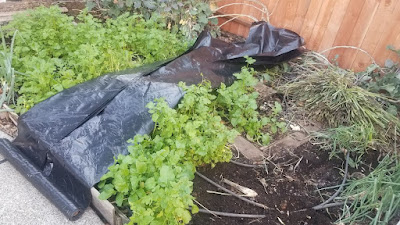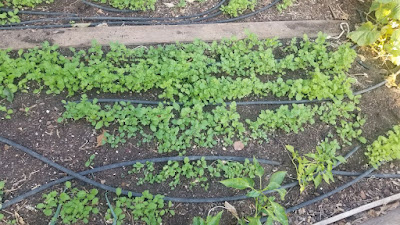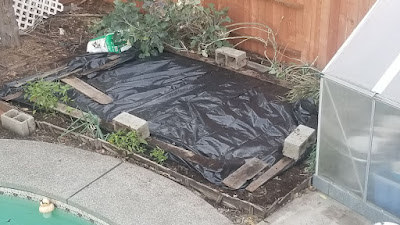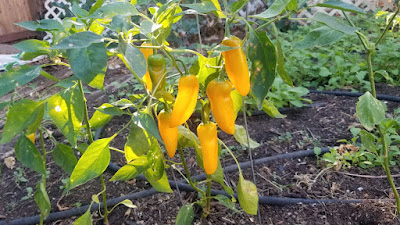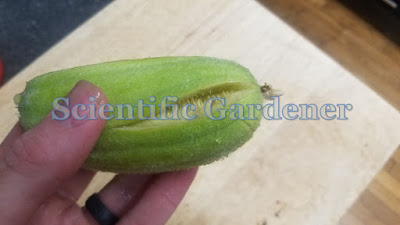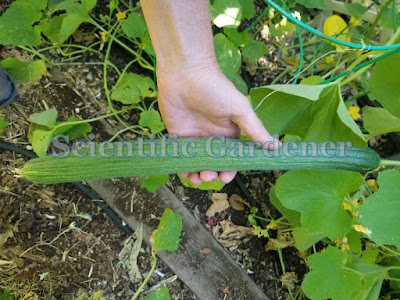For years I have been trying to grow out a long variation of my Dark Long Armenian cucumber or Tortarello Verde Barese. This is a very long, mainly straight, beautiful specimen. I grew it more than once and unfortunately failed at growing it to seed more than once as well. This year I decided to stop messing around. Previously, I had started this long-season cucumber in the middle or near the end of the season and had encountered either pest or disease. This year I decided I would start at the beginning of the season and have good healthy plants ready to go early on.








So I started the transplants in soil blocks and I set them out in the garden. They were growing well. I was so excited for them that I decided to do something extra. Our neighbor had recently mowed their grass and put them in their green bin. I had used their lawn clippings before and looked to make sure that there were still weeds growing on their lawn (important to ensure that the lawn has not been applied with a broadleaf herbicide). The renters seemed nice enough and owner would come by occasionally to mow the lawn and throw lots of lawn clippings in the green bin. So – being the earth friendly person I was, why should I allow such wonderful grass clippings to just be hauled off to the dump? So one day, I decided to dig them out and throw them in the garden.







Those of you who have seen plants exposed to broad-leaf herbicides know that it is no joke. They make quick work of any plant that is not in the grass family. About the time that I began noticing the decline of health in the plants, I did my best to remove the leaves, but the damage was done. They doddled for over 2 weeks on the edge of death. In the meantime, I decided to start another set. Another thing I did to help the situation is to triple sterilize the soil. While I will not get into the details of it all, I put the affected soil in a bag with brassicas, fertilizer and water and sealed it tight in the greenhouse to cook.







When the triple sterilization was over, I put the soil back, planted out the new transplants and prayed that it would work. It worked like a charm! The little plants shot up so fast that I was nearly shocked -or at very least very surprised. I didn’t know if it was the sterile soil or the fertilizer, but the plants thrived. Good thing too, because the days were starting to really warm up.
I made sure that the plants got plenty of sun. I grew them in front of the Sikkim cucumbers and it was a good thing too. The Sikkim cucumbers were taking their time getting established and taking even longer deciding when they were going to begin setting fruit. The Long Dark Armenians didn’t need any time to decide that. Unlike regular Armenians that begin fruiting when about 3-4 feet in diameter, the Long Dark Armenian cucumbers usually grow about 5-6 feet in diameter before they begin fruiting.




One thing I really like about growing out delicious cucumbers is that even when things don’t work out, that’s okay. Despite how nice it would be to have everything work out the first time, the challenge of having to select out traits is interesting and eating the food that doesn’t make the cut is even better. So when the first vines began producing dark female fruit, I was able to determine what vines were destined to become seed and which were going into my next salad, just by looking at their length. Once the smaller fruits had become large enough to eat, I could trace their vines back to the root and remove them from the garden to eliminate their male flowers from the population and make room for the preferred vines that would produce the more desirable fruit.




Near the end of the season, I noticed that some of the Long Dark Armenian fruit was not as dark as I would have thought it should be. For those whose fruit should have been darker, I set aside as inferior seed and made sure to let the vines with the darkest fruit remained as long as possible so as to preserve the seed of the longest and darkest cucumbers.
In the end I ended up with three types of cucumbers. Those that were very long, but not completely dark, a few that were shorter and a good quantity of long dark ones. I was pleased with the increased general length of the fruit, though am still concerned about improving the color. In any case, I would say that was a good year for the Long Dark Armenian cucumber. It produced plenty of tasty fruit for my family and friends and produced some seed too.
